Metrolinx Davenport Diamond Meeting: 2016-04-27
Published on Apr 28, 2016
A mostly complete video of Metrolinx’s meeting regarding the Davenport Diamond Grade Separation on April 27 2016, at St. Sebastien Catholic School
by Vic Gedris.
Metrolinx Davenport Diamond Meeting: 2016-04-27
Published on Apr 28, 2016
A mostly complete video of Metrolinx’s meeting regarding the Davenport Diamond Grade Separation on April 27 2016, at St. Sebastien Catholic School
by Vic Gedris.
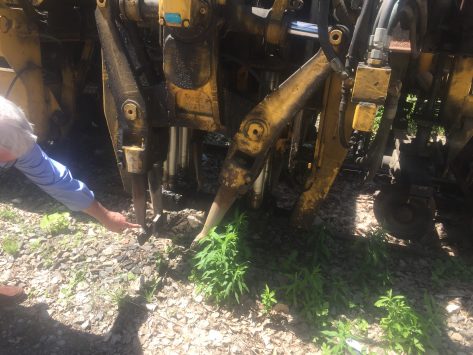
A still from the blog authors filming this weekend, where the crew again informs me to look at the camera.

Maintaining a railroads steel rail, sleepers and ballest contributes greatly to the safety of a railroads running track or yard storage track.
… some text from a rail tamper machine manufacturer, that makes a tamper commonly used in Ontario.
When a train travels over a track, it generates enormous forces. The entire track consisting of rails, sleepers and ballast is an elastic system that deforms and returns to its original position.
Over the long term this high stress results in deterioration of the track geometry. This can lead to anomalies, which means that the ideal geometry of the track is no longer assured and in these areas it becomes necessary to impose temporary speed restrictions.
To avoid such a situation, tracks should be maintained at regular intervals – this includes levelling, lifting, lining and tamping. This ensures that the ideal geometry of the track is restored.
 Now that the sound barrier wall is being set in place along the Dundas St. W. / Dupont curve, you can really see that this imposing structure is going to destroy one of the most beautiful street curves in the Junction.
Now that the sound barrier wall is being set in place along the Dundas St. W. / Dupont curve, you can really see that this imposing structure is going to destroy one of the most beautiful street curves in the Junction.
In every area history, light, wind, and sound was able to flow across the tracks providing a real experience of the community. One where people lived, worked and coexisted creating a very special, culture owned by all. The Junction was and is a special place in the city where that a melded spirit can be and is created for common purpose and joy.
This blog author and I think everyone else will surely miss the light streaming across the tracks and on to Dundas St. W. The sound of the bend is missed now as it has been gone for so long.
The wall being set in place now is to “protect” the area from the noise of commuter trains.
The City of Toronto’s City Planning Division and the to link downtown with the Bloor-Danforth Subway east of the Don River.
Report on the development of Toronto’s transit network plan
A staff report on the development of Toronto’s transit network plan is being presented to the City’s Execuitve Committee on March 9. This report recommends that the City
Approve Pape to Downtown via Queen/Richmond as the preferred corridor for the Relief Line project
For more information about the corridor analysis and to provide your feedback, please visit the project webpage.
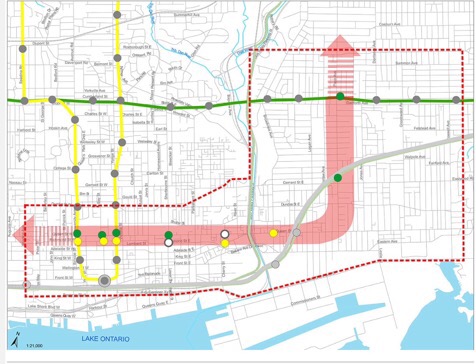
City staff report are the Continue reading link
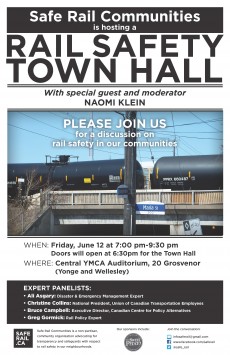
Click on image for full size view.
all text the group.
Since March 2014, Safe Rail Communities has been advocating for greater safeguards and transparency with respect to the transportation by rail of dangerous goods, particularly volatile crude oil.
Despite the tragic loss of 47 lives during the July 6th, 2013 rail disaster in Lac-Mégantic, Canadians have witnessed two more fiery crude oil derailments in 2015. These derailments occurred within three weeks of each other, and both just outside the same town of Gogoma in northern Ontario. Each of these explosive derailments, as well as those of 2014, demonstrate that Minister Raitt’s response to the situation has been largely ineffective.
Please join us for an informative meeting on this important issue with special guest and moderator, Naomi Klein, and a panel of experts:
Invited guests include Minister Raitt, NDP Transport Critic Hoang Mai, and Liberal Transport Critic David McGuinty. Also invited are all GTA MPs with rail lines in their riding, Mayor John Tory, and all Toronto City Councillors.
Please share this event on Facebook and Twitter
We look forward to seeing you there! Doors open at 6:30pm.
Patricia & Helen
Safe Rail Communities
WHEN: Friday, June 12 at 7:00 pm-9:30 pm
Doors will open at 6:30pm for the Town Hall
WHERE: Central YMCA Auditorium, 20 Grosvenor
(Yonge and Wellesley)
All text aljazeera.com
click here to view their video
London’s underground rail system has a long and storied history of being used for tasks other than transporting the city’s millions of residents.
With passenger numbers dwindling, Down Street Station closed more than 80 years ago, only to become the corridors of power during the second world war.
Twenty metres below ground and safe from German air force bombs, Prime Minister Winston Churchill, along with 25 administrative staff and soldiers, used the station to meet his war cabinet and send messages.
In 2015 there is no longer a need for such wartime preparations, but there are plans to once again revive London’s so-called ghost stations with restaurants, art galleries and even a cinema.
Speaking on the plans for Down Street Station, Graeme Craig, commercial director of Transport for London, told Al Jazeera: ”This is a unique space within London. It’s a space not used by passengers since May 1932. … It’s in the heart of Mayfair – it’s unique location, history, and space.”
Heading south from under the Keele St. Canadian Pacific Railway subway just north of Vine Ave, Sunday the 23rd of Feb. a hole lot of bumper to bumper traffic. From the experience of this the residents of the area will have to adapt themselves for a considerable new time lag in transverse travel time along the maim NS Keel St travel route as the new Stockyard Mall opens the bulk of the malls stores
March 3rd the stockyards Second cup opens.
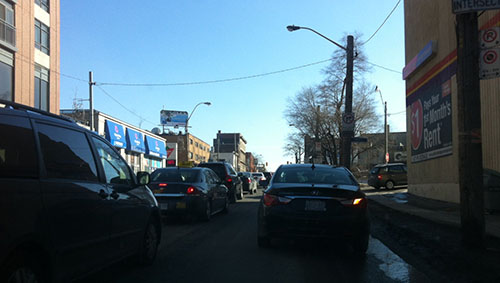

The blog has highlighted the very resonating parts…
From the media release here
….more than half Britain’s rail network will be electrified with electric trains accounting for three-quarters of all traffic.
Once electrification schemes including the Great Western and Midland main lines, Liverpool to Manchester and Preston, the Valley lines in south Wales and the ‘electric spine’ from Southampton docks to the West Midlands and Yorkshire are complete, more than half Britain’s rail network will be electrified with electric trains accounting for three-quarters of all traffic.
Simon Kirby, managing director of Network Rail’s infrastructure projects division, said: “Our work to electrify two thousand track miles represents the biggest programme of rail electrification in a generation and will provide faster, quieter and more reliable journeys for millions of passengers every week while cutting the cost of the railway.
“Thanks to a firm commitment from government to invest in electrification schemes across the country, we are transforming the railway and providing Britain with a sustainable, world-class transport system that is fit for the future. To deliver this work in the safest and most efficient way possible, we need to make the most of the huge potential within our supply chain.”
Six geographic framework contracts have been awarded, with each having a defined workbank of schemes to be delivered. This approach has been endorsed by the supply chain and industry groups such as the Railway Industry Association.
Simon Kirby continued: “With billions of pounds set to be invested in electrification schemes over the next decade, and with many projects at different stages of development, it is absolutely vital that the supply market gets a clear, consistent message from Network Rail about what the company needs from its supply partners, where and when.
“The framework approach chosen by Network Rail gives suppliers a greater degree of certainty about the company’s pipeline of work and means suppliers can target investment so they have the right people with the right skills in the right parts of the country to deliver schemes which will improve our railway and boost economic growth.”
All text Go Transit,
What we are doing
• We are grading and installing track and signals between Lansdowne Avenue and Dupont Street to complete the expanded rail corridor for increased transit service.
• We are accessing the corridor at two locations to finish construction by the end of this year. The first is already in use at Dundas Street West and Brad Street. The second access will be at 158 Sterling Road where we will also store new track materials.
• Trucks will cross the West Toronto Railpath to enter and exit the rail corridor at the Sterling Road location.
How this will affect you
• We will begin to use the 158 Sterling Road access/storage on early February until the end of 2014.
• Railpath users will have the right-of-way over construction vehicles. A traffic control person will be positioned at the access point during construction hours. Appropriate signage will be in place along the path advising users of the condition ahead. Signage will also be placed along the access road reminding drivers to stop and yield to railpath users.
• Regular work hours are Monday to Friday 7 a.m. to 7p.m., Saturdays 9 a.m. to 7 p.m. There may be occasional work on Sundays from 9:00 a.m. to 5:00 p.m.
• We expect an average of 8 to 10 trucks per hour to use this access on a daily basis.
• All trucks will travel along Sterling Road from Dundas Street West to access the construction site.
• We will regularly clean the roads our trucks will be using, including the West Toronto Railpath.
Toronto as a city – the elected members and the public talk, talk, talk about transit, then agree somewhat and start, then cancel mid construction, well you know the story.
However what if we just jumped ahead to the next obvious transport method, that is what happened when Stephenson’s Rocket came along.
We did it before! People were excited in 1977 to view inside the TTC Wychwood Barns to view the exciting and then new fleet of street-cars which ride our street rails.
below is a link to Elon Musk document – released days ago – of his HYPERLOOP rail transport idea, the tech is amazing as well as the practical thoughts to get it done.
…a great read, for transit brilliance, OH, and if you are into start-up pitches also educative.
If we are to make a massive investment in a new transportation system, then the return should by rights be equally massive. Compared to the alternatives, it should ideally be:
• Safer
• Faster
• Lower cost
• More convenient
• Immune to weather
• Sustainably self-powering
• Resistant to Earthquakes
• Not disruptive to those along the route
Is there truly a new mode of transport – a fifth mode after planes, trains, cars and boats – that meets those criteria and is practical to implement? Many ideas for a system with most of those properties have been proposed and should be acknowledged, reaching as far back as Robert Goddard’s to proposals in recent decades by the Rand Corporation and ET3.
Unfortunately, none of these have panned out. As things stand today, there is not even a short distance demonstration system operating in test pilot mode anywhere in the world, let alone something that is robust enough for public transit. They all possess, it would seem, one or more fatal flaws that prevent them from coming to fruition.
The links again
A simple post of a article hat highlights the similar road issues Toronto has and possible methods to pay for the repair and replacement of our crumbing roads.
…all excerpts below from the article, much more in the complete article.
The sheer size of those needs, combined with a diminishing capacity to pay for it with public money, may speed up private sector involvement in the province unlike anything seen before in Canada.
“We believe this year is going to be a game-changer,” said Vincent Joli-Coeur, vice-chairman of National Bank Financial, which has participated in several major infrastructure financings including the bond sale for Montreal’s $2.6-billion CHUM hospital redevelopment. “In the past, we used to be able to spend years discussing new ways of [project procurement and funding]. Now it’s imminent.”
The only question is just how creative Quebec will get with its funding solutions. Mr. Joli-Coeur believes necessity will push the province to bring in private investors such as pension plans to fund things that were previously unthinkable, including public transit development.
“Public transit, in our view as financiers, is the next frontier,” he said. “It’s never been financed in the private sector in Canada.”
Ontario, too, wants to undertake a massive public transit expansion in the Toronto-Hamilton area. To pay for it, a government-appointed advisory panel in December recommended raising existing gasoline taxes as much as 10¢ per litre to 24.7¢ and weighing an increase in the province’s harmonized sales tax. The panel also discussed increasing corporate taxes and using a mechanism known as “land value capture,” which would collect part of the increase in the value of land located near new transit lines.
Most of those solutions wouldn’t fly in Quebec without drawing significant public protest. Quebec motorists already pay 22.2¢ per-litre in gas tax, and with salaries barely budging year-over-year, people won’t want to pay much more. Meanwhile, the government already increased its provincial sales tax in both 2011 and 2012.
“Most of the revenue tools [being contemplated] by Ontario to finance public transit will have a hard time being sold in Quebec,” Mr. Joli-Coeur said. “The conventional ways of doing things … has to change.”
Take Hong Kong. The city’s Mass Transit Railway Corp. (MTR) carries five million passengers every weekday over 218 kilometres of rail lines, offering its customers things other transit systems only dream of: 3-G and free wi-fi telecommunications service for passengers, public computers, library book drops, elevators down to track-level, and first-class cars on longer routes. It’s one of the few transit agencies anywhere that actually makes money.
“If the infrastructure is not self-sustaining, it cannot rely on public funding always being there,” MTR chief executive Jay Walder told an audience last year at Harvard University. “At some point politics simply diverts the money elsewhere.”
The thinking in all of these mechanisms is that expanding transit boosts the value of property near the transit lines, and that those who benefit from that should contribute to the cost. The tricky part, however, lies in how to go about it. Tax businesses too much and you risk scaring them away. Ask too little and you don’t generate enough money to fund your projects.
“The development community are not adverse to participating in the cost of certain transportation investments because they know that they are the beneficiary,” said Blake Hutcheson, chief executive of Oxford Properties, the real estate investment arm of pension fund manager OMERS. “The difficulty is how do you get at that, how do you quantify it?”
Oxford Properties is involved in a separate real-estate/transit development project in Manhattan called Hudson Yards.
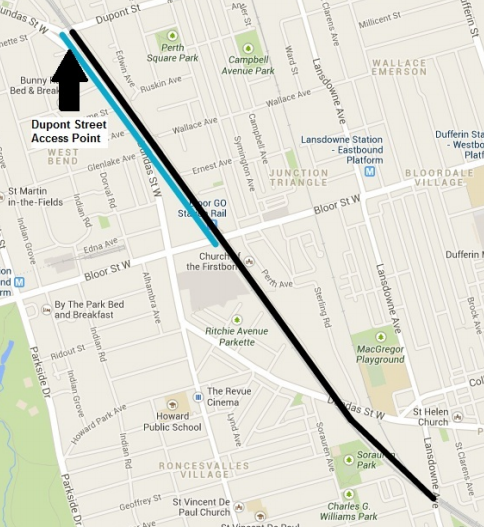
all text from Go Transit
What we are doing
• The next phase of the East Corridor Grading, Track and Signals project has started. This phase will focus on installing new tracks and signals between Lansdowne Avenue and Dupont Street and is expected to last until fall 2014.
• We will access the rail corridor near Dupont Street, adjacent to Brad Street to complete this work.
o An average of 2 to 3 dump trucks per hour will enter and exit at this location.
Continuous Overnight Work – December 6 to 8
• Beginning at 7:00 p.m. on Friday, December 6 and continuing until Sunday, December 8 at 5:00 p.m. we will be shifting tracks and testing signals between the Bloor GO station and Dupont Street. There is a possibility work may extend into Sunday night.
• This work can only be done outside of regular train service.
How this will affect you
• We will perform regular street sweeping of the roads our trucks will be using.
• For the work between December 6 and 8, residents living nearby can expect some noise associated with construction vehicles and from the welding and re-positioning of rail tracks.
• Lights will be used during overnight hours; however, they will be focused away from nearby homes.
• The normal scheduled work hours for this project are Monday to Friday from 7:00 a.m. to 7:00 p.m. and 9:00 a.m. to 5:00 p.m. on weekends.
• There will be further continuous weekend and overnight work which will be communicated in advance to the community.
East Corridor Mailing List
We want to maintain regular communications with our neighbours while work is being completed. To receive updates and information about the work in your community, please send an email to gts@gotransit.com referencing the East Corridor mailing list and include your name, address, telephone number and email.
Thank you for your patience as we work on the East Corridor Grading, Track and Signals Project
Recent Comments